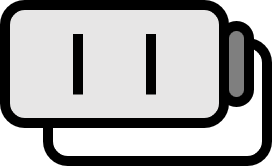Sobolev Norm and Sobolev Spaces
Definition1
Sobolev Space
Let $\Omega \subset \mathbb{R}^{n}$ be an open set. For positive integers $m$ and $1\le p \le \infty$, the function space defined as follows is called the Sobolev space.
$$ W^{m, p}(\Omega):=\left\{ u \in L^{p}(\Omega) : D^\alpha u \in L^{p}(\Omega)\quad \forall 0\le |\alpha | \le m \right\} $$
Here, $\alpha$ is a multi-index, $D^\alpha u$ is a weak derivative, and $L^{p}$ is a Lebesgue space.
Sobolev Norm
For positive integers $m$ and $1\le p \le \infty$, let us define the function $\left\| \cdot \right\|_{m,p}$ as follows.
$$ \|u\|_{m,p} =\left( \sum\limits_{0\le |\alpha| \le m } \|D^\alpha u \|^p_{p} \right)^{\frac{1}{p}}, \quad 1\le p<\infty $$
$$ \|u\|_{m,\infty}= \max\limits_{0\le |\alpha| \le m} \|D^\alpha u\|_\infty, \quad p=\infty $$
This becomes the norm of the Sobolev space.
Explanation
Simply put, the Sobolev space is a set of functions whose derivatives up to the $m$-th order all belong to $L^{p}$. While the $L^{p}$ space has useful properties and is an important space, it might be somewhat insufficient for solving differential equations. We need to consider spaces with more properties than the $L^{p}$ space, and that is precisely the Sobolev space.
Clearly, if $m=0$ then $W^{0, p}=L^{p}$. Also, since $C_{0}^\infty$ is dense in $L^{p}$, when $1 \le p < \infty$ then $W_{0}^{0,\ p}=L^P$. Additionally, the following embedding exists, making $W^{m, p}$ treatable as a subspace of $L^{p}$.
$$ W_{0}^{m, p}(\Omega) \to W^{m, p}(\Omega) \to L^{p}(\Omega) $$
The following three function spaces all have the Sobolev norm $\left\| \cdot \right\|_{m,p}$. For positive integers $m$ and $1\le p \le \infty$,
$$ \begin{equation} W^{m, p}(\Omega):=\left\{ u \in L^{p}(\Omega) : D^\alpha u \in L^{p}(\Omega)\quad \forall 0\le |\alpha | \le m \right\} \end{equation} $$
$$ \begin{equation} H^{m, p}(\Omega):= \text{the completion of } \left\{ u \in C^m(\Omega) : \|u\|_{m, p} < \infty \right\} \end{equation} $$
$$ \begin{equation} W_{0}^{m, p}(\Omega):= \text{the closure of } C^\infty_{0}(\Omega) \text{ in } W^{m, p}(\Omega) \end{equation} $$
Here, $(1)$~$(3)$ are called Sobolev spaces. $H^{m, p}$ and $W^{m, p}$ can actually be shown to be the same.
Symbols used to denote the Sobolev space include $H^{m, p}, W^{m, p}, P^{m, p}, L_{p}^{m}$, among others. Also, before the name Sobolev space became established, it was sometimes called a Beppo Levi space.
Properties
(a) Sobolev space is a Banach space.
(b) When $1\le p <\infty$, the Sobolev space is separable.
(c) When $1\le p < \infty$, the Sobolev space is reflexive and uniformly convex.
Ole Christensen, Functions, Spaces, and Expansions: Mathematical Tools in Physics and Engineering (2010), p59-61 ↩︎
